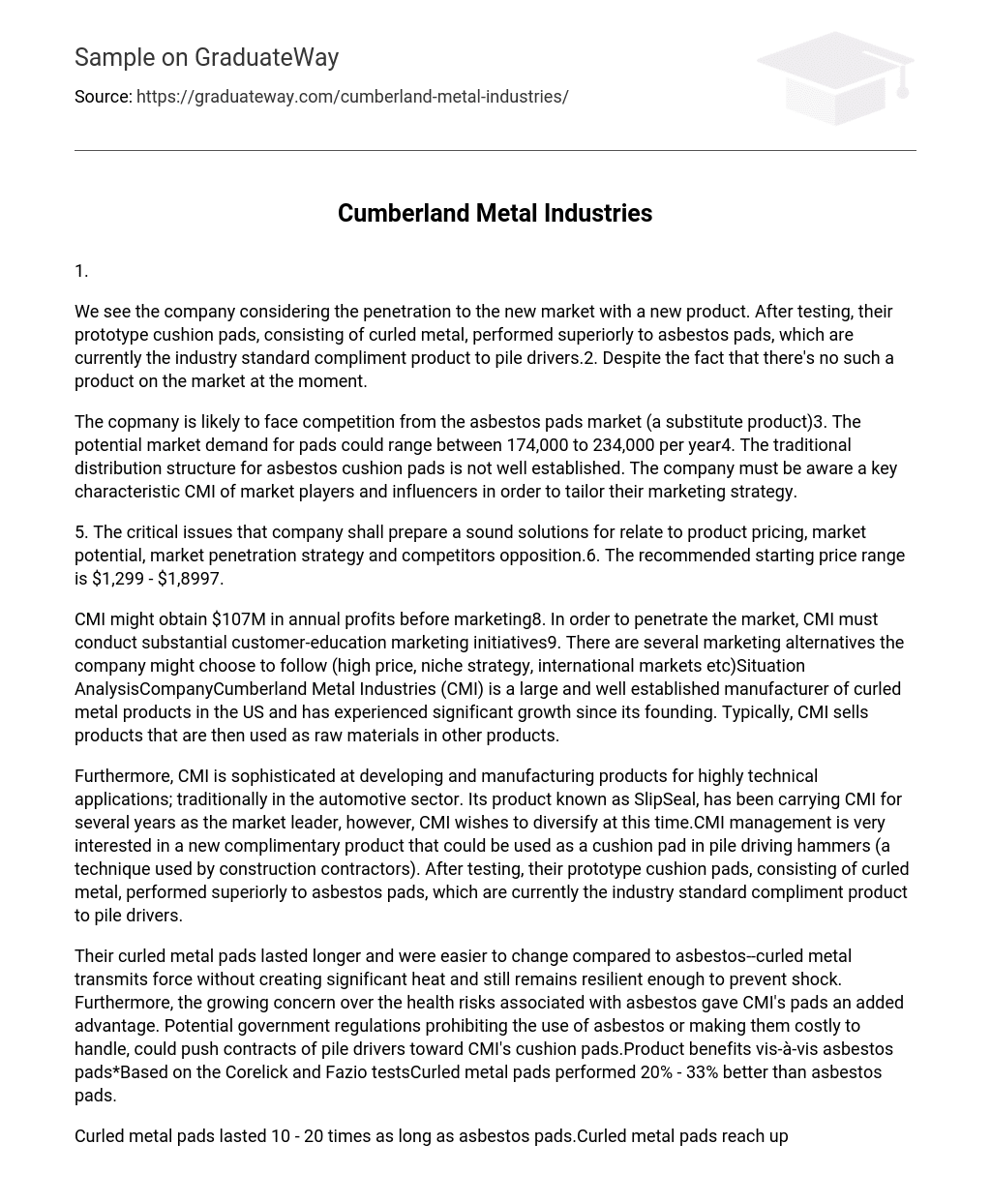Paragraph 1.
The company is considering entering a new market with a new product. They have tested their prototype cushion pads, made of curled metal, and found them to perform better than asbestos pads, which are currently the industry standard complement to pile drivers. However, it is worth noting that this product is not currently available on the market.
The company is expected to face competition from the market for asbestos pads, which are a substitute product3. The potential demand for pads in the market could range between 174,000 to 234,000 per year4. The distribution structure for traditional asbestos cushion pads is not well established. Therefore, the company needs to understand a key characteristic of market players and influencers known as CMI in order to customize their marketing strategy.
5. The company needs to address critical issues pertaining to product pricing, market potential, market penetration strategy, and opposition from competitors. 6. It is recommended that the starting price range should be between $1,299 and $1,899. 7.
CMI could potentially earn $107M in yearly profits prior to marketing8. To enter the market, CMI needs to carry out extensive marketing campaigns9 to educate customers. There are various marketing options available for the company, including high pricing, niche strategy, and entering international markets.
Situation Analysis
Company
Cumberland Metal Industries (CMI) is a reputable and sizable manufacturer based in the US. CMI specializes in producing curled metal products and has achieved considerable growth since its establishment. Typically, CMI sells its products as raw materials for other goods.
Moreover, CMI specializes in the development and production of advanced products for specialized applications, particularly in the automotive industry. One of its flagship products, known as SlipSeal, has dominated the market for several years. However, CMI now aims to broaden its product portfolio. In particular, CMI’s management is seeking a new complementary product that can function as a cushion pad in pile driving hammers. This technique is commonly used by construction contractors. Upon testing, CMI’s prototype cushion pads, made of curled metal, outperformed the industry standard asbestos pads currently used to complement pile drivers.
The curled metal pads provided by CMI offer several advantages over asbestos pads. Firstly, they have a longer lifespan and are easier to replace. Additionally, the metal is able to transmit force without generating excessive heat, while still maintaining its resilience to prevent shocks. These benefits become even more significant considering the increasing concerns regarding the health risks associated with asbestos. The possibility of future government regulations banning or increasing the cost of using asbestos pads could potentially drive pile driver contracts towards CMI’s cushion pads.
When comparing the benefits of CMI’s pads to asbestos pads, based on the Corelick and Fazio tests, it was found that curled metal pads performed 20% – 33% better.
Curled metal pads have a lifespan 10-20 times longer than asbestos pads. While curled metal pads reach a maximum temperature of 250 degrees Fahrenheit, asbestos pads can reach a hazardous and time-consuming temperature of 700 degrees Fahrenheit. As a result, fewer curled metal pads are needed to drive a greater distance, resulting in fewer set changes, reduced downtime, and fewer potential injuries. Currently, the perception is that pads are only necessary and not a means to save costs and improve performance, leading to them being overlooked.
CompetitorsCMI was the first company to introduce curled metal pads to the market, giving them an advantage with no direct competition. However, they did face competition from the asbestos pads market. The good news is that there are no significant players in the asbestos pads market. In fact, most pads in this market are unbranded and are often given for free when contractors purchase or rent other supplies. This might reduce contractors’ loyalty to asbestos pads.
Hence, CMI is not likely to face intense competition from asbestos pads. However, CMI is worried about potential competitors entering the market as the product can be easily replicated and the resources needed for production are readily available. CMI needs to consider this competition when making pricing decisions (See Recommendation). According to industry sources, CMI believes that companies directly involved in pile driving own approximately 13,000 pile hammers, with an additional 6,500 to 13,000 being leased.
Moreover, hammers are used for 30 hours every week and for a total of 25 weeks each year, resulting in a total of 750 hours of operation per hammer annually. It is also estimated that an average job requires driving piles for 20 feet per hour. Consequently, the annual pile feet driven range from 290M to 390M. Consequently, the potential market demand for pads can vary from 174,000 to 234,000 per year.
The initial step CMI needs to take in effectively promoting its new pads is determining the market players. For instance, using the calculation of 390M ft divided by 0.010M ft, multiplied by 6 pads, equals 234,000 pads. (See Recommendation for market size in dollars).
The pile manufacturers, architectural/consulting engineers, soil consultants, pile hammer distributing/renting companies, engineering/construction contractors, and independent pile-driving contractors are the key industry constituents. CMI must be aware of the unique characteristics of each player in order to customize their marketing strategy.





